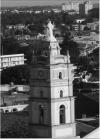Resumen
El Centro Histórico Urbano de Camagüey posee valores patrimoniales excepcionales que lo hicieron merecedor de ser incluidoen la Lista del Patrimonio Mundial de la UNESCO, en el 2008, sintetizados en: “Una de las siete primeras villas fundadas porlos españoles en Cuba, Camagüey juega un prominente papel como centro urbano del territorio interior dedicado a la cría deganado y la industria azucarera. Una vez asentado en su actual localización en 1528, la villa se desarrolla en base a un modelourbano irregular que contiene un sistema de plazas, plazuelas, calles sinuosas, callejones y manzanas irregulares muyexcepcionales entre las villas latinoamericanas localizadas en terrenos planos…”En el trabajo se expone como desde 1998 se aplica en el Centro Histórico de la Ciudad de Camagüey, Cuba, a través de lacreación de la Oficina del Historiador de la Ciudad, el Modelo Cubano para la Gestión de los Centros Históricos, con enfoque desostenibilidad, probado en La Habana Vieja desde 1993. Sus resultados evidencian la viabilidad del modelo que ha permitido,junto a los valores patrimoniales que ostenta, la declaratoria de Patrimonio Mundial en el año 2008.La revista Apuntes se encuentra registrada bajo la licencia Creative Commons Reconocimiento 4.0 Internacional. Por lo tanto, esta obra se puede reproducir, distribuir y comunicar públicamente en formato digital, siempre que se reconozca el nombre de los autores y a la Pontificia Universidad Javeriana. Se permite citar, adaptar, transformar, autoarchivar, republicar y crear a partir del material, para cualquier finalidad (incluso comercial), siempre que se reconozca adecuadamente la autoría, se proporcione un enlace a la obra original y se indique si se han realizado cambios. La Pontificia Universidad Javeriana no retiene los derechos sobre las obras publicadas y los contenidos son responsabilidad exclusiva de los autores, quienes conservan sus derechos morales, intelectuales, de privacidad y publicidad.
El aval sobre la intervención de la obra (revisión, corrección de estilo, traducción, diagramación) y su posterior divulgación se otorga mediante una licencia de uso y no a través de una cesión de derechos, lo que representa que la revista y la Pontificia Universidad Javeriana se eximen de cualquier responsabilidad que se pueda derivar de una mala práctica ética por parte de los autores. En consecuencia de la protección brindada por la licencia de uso, la revista no se encuentra en la obligación de publicar retractaciones o modificar la información ya publicada, a no ser que la errata surja del proceso de gestión editorial. La publicación de contenidos en esta revista no representa regalías para los contribuyentes.


